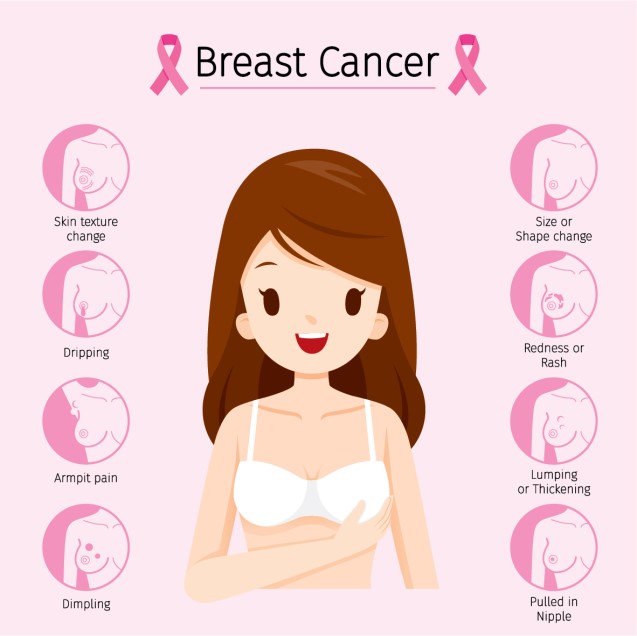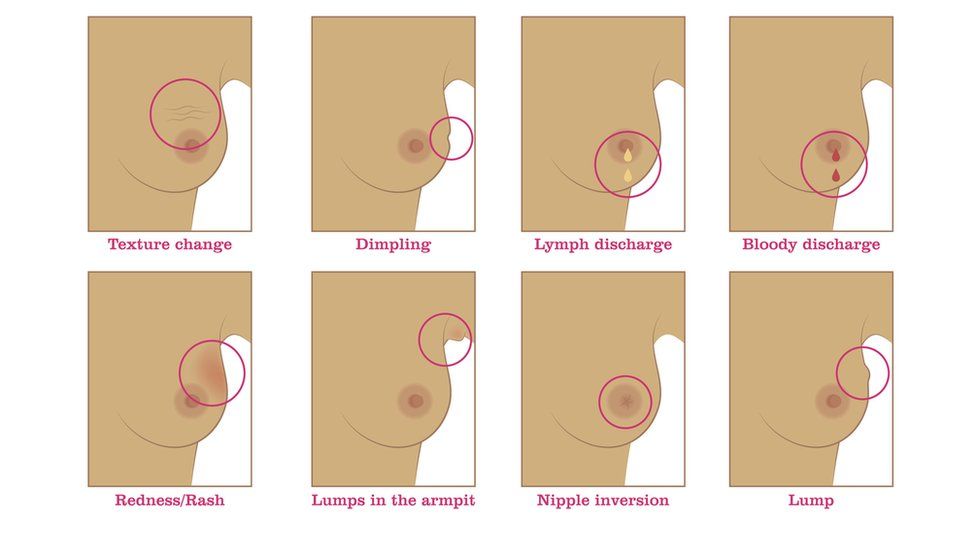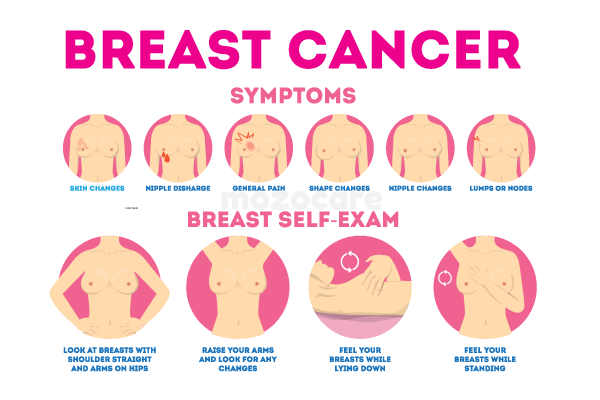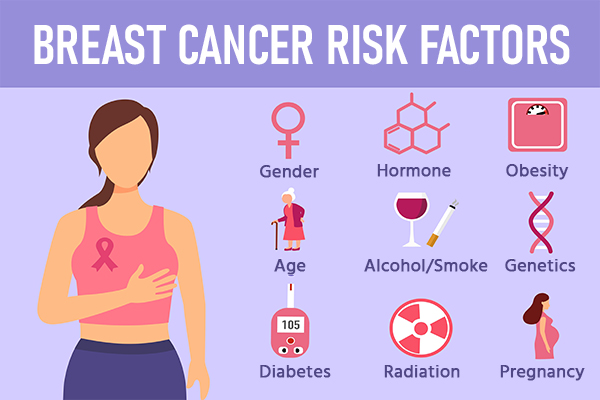Breast Cancer Symptoms in Hindi
Breast cancer is a serious and often life-threatening disease that affects thousands of women every year. Early detection and treatment are essential for increasing the chances of successful treatment and survival. In this article, we will discuss the symptoms of breast cancer, their causes, and what steps you can take to detect and treat the disease.
Breast cancer is a type of cancer that develops in the breast tissue. It can occur in both men and women, but it is more common in women. The disease can start in the cells of the milk ducts or the lobules, which are the glands that produce milk. Breast cancer can also spread to other parts of the body, such as the lymph nodes, bones, or liver.
Breast Cancer Symptoms in Himdi
One of the most common symptoms of breast cancer is a lump or thickening in the breast tissue. This lump may feel hard or tender and may be accompanied by pain or discomfort. Other symptoms of breast cancer include:
- Changes in breast size or shape: The breast may become larger or smaller, or it may become misshapen.
- Skin changes: The skin on the breast may become red, inflamed, or dimpled. There may also be changes in the texture of the skin, such as puckering or scaling.
- Nipple changes: The nipple may become inverted, or there may be discharge from the nipple that is not milk.
- Pain or discomfort: Breast cancer may cause pain or discomfort in the breast, nipple, or surrounding area.
Changes in breast size
Changes in breast size or shape can be a symptom of breast cancer. This symptom may involve one breast or both breasts and can occur gradually over time or more suddenly. Some changes in breast size or shape that may be indicative of breast cancer include:
- Swelling or thickening of the breast tissue: This can cause the breast to become larger or misshapen.
- Shrinking or dimpling of the breast tissue: This can cause the breast to become smaller or appear sunken in.
- Changes in the position of the nipple: This can include the nipple becoming inverted (pointing inward instead of outward) or changing position on the breast.
- Skin changes on the breast: This can include redness, scaling, or puckering of the skin on the breast.
It is important to note that changes in breast size or shape can be caused by other conditions besides breast cancer, such as fibrocystic breast disease or hormonal changes. However, any changes in breast tissue should be examined by a healthcare provider to rule out the possibility of breast cancer.
If you notice any changes in the size or shape of your breast tissue, it is important to see a healthcare provider as soon as possible. Your healthcare provider may perform a clinical breast exam or recommend additional diagnostic tests, such as a mammogram or ultrasound. Early detection of breast cancer is essential for successful treatment and improved chances of survival.
Skin changes
Skin changes on the breast can be a symptom of breast cancer. These changes can include redness, scaling, or puckering of the skin on the breast. Other skin changes that may be indicative of breast cancer include:
- Dimpling or thickening of the skin: This can cause the skin on the breast to appear puckered or resemble the skin of an orange.
- Changes in texture or color: This can include the skin becoming rough or scaly, or changing color to red or pink.
- Peeling or flaking of the skin: This can occur on the nipple or the areola (the dark-colored area around the nipple).
- Itching or burning: This can occur on the breast or the nipple.
It is important to note that skin changes on the breast can be caused by other conditions besides breast cancer, such as a skin infection or allergic reaction. However, any skin changes on the breast should be examined by a healthcare provider to rule out the possibility of breast cancer.
If you notice any skin changes on your breast, it is important to see a healthcare provider as soon as possible. Your healthcare provider may perform a clinical breast exam or recommend additional diagnostic tests, such as a mammogram or ultrasound. Early detection of breast cancer is essential for successful treatment and improved chances of survival.
The Acid Reflux Strategy
Nipple changes
Nipple changes can be a symptom of breast cancer. These changes can include:
- Nipple inversion: This occurs when the nipple that was previously pointing outward is pulled inward. It can occur in one or both nipples.
- Changes in nipple position: The nipple may shift position or angle on the breast.
- Changes in nipple texture: The nipple may become scaly, flaky, or crusty.
- Nipple discharge: This can include a clear, bloody, or milky discharge from the nipple.
It is important to note that nipple changes can also be caused by non-cancerous conditions, such as an infection or hormonal changes. However, any changes in the nipple should be examined by a healthcare provider to rule out the possibility of breast cancer.
If you notice any changes in your nipples, it is important to see a healthcare provider as soon as possible. Your healthcare provider may perform a clinical breast exam or recommend additional diagnostic tests, such as a mammogram or ultrasound. Early detection of breast cancer is essential for successful treatment and improved chances of survival.
Pain or discomfort
Pain or discomfort in the breast can be a symptom of breast cancer, although it is not always a definitive sign. Breast cancer-related pain can manifest in different ways, including:
- A persistent ache or throbbing sensation in the breast or armpit.
- A sharp pain or stabbing sensation in the breast that may occur intermittently.
- A feeling of pressure or heaviness in the breast.
- Soreness or tenderness in the breast or nipple.
It is important to note that breast pain or discomfort can also be caused by non-cancerous conditions, such as hormonal changes, cysts, or injuries. However, any persistent or unusual breast pain or discomfort should be examined by a healthcare provider to rule out the possibility of breast cancer.
If you experience persistent or unusual breast pain or discomfort, it is important to see a healthcare provider as soon as possible. Your healthcare provider may perform a clinical breast exam or recommend additional diagnostic tests, such as a mammogram or ultrasound. Early detection of breast cancer is essential for successful treatment and improved chances of survival.
It is important to note that not all lumps or changes in the breast are cancerous. Many breast lumps are benign, meaning they are not cancerous. However, it is essential to see a healthcare provider if you notice any changes in your breast tissue, as early detection and treatment can greatly improve the chances of successful treatment and survival.
The exact causes of breast cancer are not fully understood, but several risk factors have been identified. These include:
- Age: The risk of breast cancer increases as you get older.
- Gender: Breast cancer is more common in women than in men.
- Family history: A family history of breast cancer increases the risk of developing the disease.
- Hormonal factors: Exposure to estrogen and progesterone hormones can increase the risk of breast cancer.
- Lifestyle factors: Smoking, alcohol consumption, and a lack of physical activity can increase the risk of breast cancer.
If you experience any of the symptoms of breast cancer or have any risk factors for the disease, it is important to see a healthcare provider for a clinical breast exam and, if necessary, a mammogram or other diagnostic tests.
Treatment for breast cancer depends on several factors, including the stage and type of cancer, as well as the patient's overall health and preferences. Treatment options may include surgery, radiation therapy, chemotherapy, hormone therapy, or targeted therapy.
In conclusion, breast cancer is a serious disease that can affect anyone, but early detection and treatment can greatly improve the chances of successful treatment and survival. It is important to be aware of the symptoms of breast cancer and to see a healthcare provider if you notice any changes in your breast tissue. By taking these steps, you can help protect your health and reduce your risk of developing breast cancer.
Prevention
Breast cancer prevention is a crucial aspect of overall breast health. Although there is no sure way to prevent breast cancer, there are steps that women can take to reduce their risk of developing this disease. Here are some strategies for breast cancer prevention:
- Regular screening: Women should begin screening for breast cancer at age 40, or earlier if they have a family history of the disease. Screening can include a clinical breast exam and mammogram, as well as additional diagnostic tests if necessary.
- Healthy lifestyle choices: Maintaining a healthy lifestyle can reduce the risk of breast cancer. This includes maintaining a healthy weight, engaging in regular physical activity, limiting alcohol intake, and avoiding smoking.
- Breastfeeding: Women who breastfeed for a longer period of time have a lower risk of breast cancer. Breastfeeding can also provide other health benefits for both mother and baby.
- Hormone therapy: Women who use hormone therapy to manage menopausal symptoms may have an increased risk of breast cancer. Women should talk to their healthcare provider about the risks and benefits of hormone therapy.
- Genetic testing: Women with a family history of breast cancer may benefit from genetic testing to determine if they have a genetic mutation that increases their risk of the disease. Women who test positive for a mutation may consider more frequent or earlier screening, as well as other risk-reducing strategies.
- Environmental factors: Some environmental factors, such as exposure to certain chemicals, may increase the risk of breast cancer. Women should try to limit their exposure to these substances whenever possible.
- Healthy diet: A healthy diet can help reduce the risk of breast cancer. This includes eating a diet rich in fruits, vegetables, whole grains, and lean protein, and limiting processed and high-fat foods.
- Regular exercise: Engaging in regular physical activity can help reduce the risk of breast cancer. Women should aim for at least 30 minutes of moderate exercise most days of the week.
- Self-exams: Women should perform monthly self-exams to become familiar with the normal texture and appearance of their breasts. This can help them detect any changes or abnormalities early on.
It is important to note that breast cancer prevention strategies may vary depending on individual risk factors and medical history. Women should talk to their healthcare provider about their individual risk of breast cancer and the best strategies for prevention.
In addition to these strategies, it is also important for women to be aware of their breast health and to report any changes or abnormalities to their healthcare provider. Early detection is key to successful treatment and improved chances of survival.
In conclusion, breast cancer prevention involves a combination of healthy lifestyle choices, regular screening, and awareness of individual risk factors. Women should talk to their healthcare provider about the best strategies for breast cancer prevention based on their individual needs and medical history. By taking proactive steps to reduce their risk of breast cancer, women can help maintain their overall breast health and wellbeing.
FAQs
Here are some frequently asked questions about breast cancer symptoms:
Q: Can breast cancer cause pain or discomfort?
A: Yes, breast cancer can cause pain or discomfort in the breast, although it is not always a definitive sign of the disease. Breast cancer-related pain can manifest in different ways, including a persistent ache or throbbing sensation, a sharp pain or stabbing sensation, a feeling of pressure or heaviness, or soreness or tenderness in the breast or nipple.
Q: Can breast cancer cause changes in breast size or shape?
A: Yes, breast cancer can cause changes in breast size or shape, although these changes can also be caused by non-cancerous conditions. Breast cancer-related changes in size or shape can include a lump or thickening in the breast, dimpling or puckering of the skin, or an inverted nipple.
Q: What are the most common breast cancer symptoms?
A: The most common breast cancer symptoms include a lump or thickening in the breast, changes in breast size or shape, skin changes, nipple changes, and pain or discomfort. However, it is important to note that not all breast cancer presents with symptoms, and some breast cancer may be detected through routine screening.
Q: How is breast cancer diagnosed?
A: Breast cancer is typically diagnosed through a combination of imaging tests and biopsies. Imaging tests may include mammography, ultrasound, or MRI, while biopsies involve removing a small sample of breast tissue for examination under a microscope.
Q: What are the risk factors for breast cancer?
A: The risk factors for breast cancer include age, family history of breast cancer, genetic mutations, personal history of breast cancer or certain non-cancerous breast conditions, exposure to estrogen, obesity, alcohol consumption, and lack of physical activity.
Q: Can breast cancer be prevented?
A: While there is no sure way to prevent breast cancer, there are steps that women can take to reduce their risk of developing the disease. These steps include regular screening, healthy lifestyle choices, breastfeeding, genetic testing, limiting exposure to environmental factors, maintaining a healthy diet, engaging in regular exercise, and performing monthly self-exams.
Q: What should I do if I notice changes in my breasts?
A: If you notice any changes in your breasts, such as a lump, changes in size or shape, skin changes, or nipple changes, you should see a healthcare provider as soon as possible. Your healthcare provider may perform a clinical breast exam, recommend imaging tests or biopsies, or refer you to a specialist for further evaluation. Early detection is key to successful treatment and improved chances of survival.



:max_bytes(150000):strip_icc()/ibc-inflammatory-breast-cancer-430621_v2-1709b25eae064bb490204f3070d423a1.png)
:max_bytes(150000):strip_icc()/the-ins-and-outs-of-nipple-changes-430663_color_alt2-5b95de9746e0fb0025d89cca.png)



Post a Comment